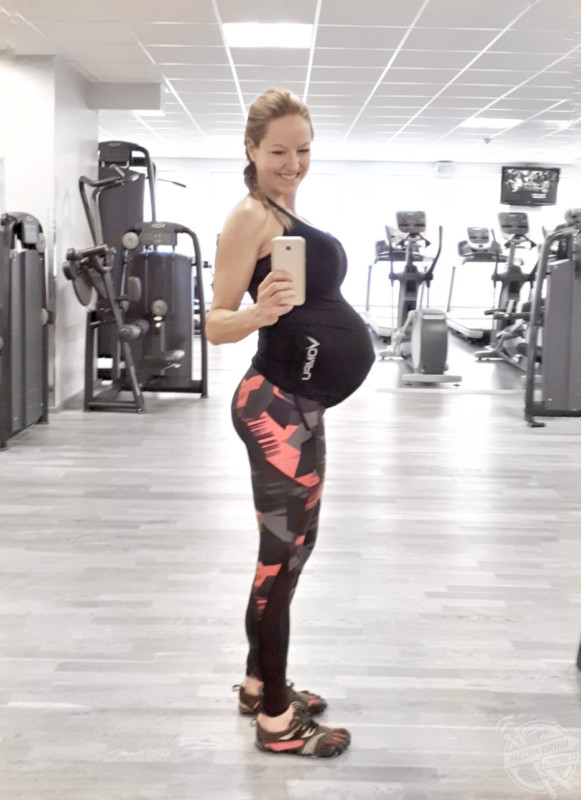By Alyce Collins
THIS second-time mother is on a mission to banish the “myth” of pregnant women being physically incapable of participating in extreme sports – by effortlessly scaling over 10 feet up a climbing wall, surfing, circus trapezing and even cartwheeling into the delivery room.
Pictures show Anna-Lee Markstedt (40) from Sweden, an obstacle course racing champ, doing handstands, impossibly difficult strength positions and snorkelling all with her bump in tow.

Anna-Lee can also be seen rock-climbing, boxing and balancing on fallen tree trunks. She wants to show other healthy mothers-to-be that you are still strong and capable whilst pregnant, and you don’t have to stop doing what you enjoy out of fear for the baby.
Anna-Lee welcomed her second child, a healthy daughter, Niama Freya Dillon Moran at the start of May.

However, Anna-Lee wants to clarify to other women who are interested in taking up these extreme sports or competing in races, that she has been practicing these sports for quite some time, and it isn’t advisable to start them after getting pregnant.
Anna-Lee received varied reactions to her training routine, with some people seeing her cautious attitude while heavily pregnant, whereas other people were quick to judge. She explained:

“My extreme sports pregnancy split people into two camps. The first are the ‘You Go Girl’ with the #PregnantNotDying mindset.
“The second are ‘That is Irresponsible’ and Must be Harmful for the baby.
“I got almost exclusively positive reactions from people who are also sporty and could see that I was being cautious. People who know me.

“But then you have the people online, without background knowledge and facts, who said I was endangering the baby. I tried to accept that they are probably just concerned.”
However blasé she may sound, after falling pregnant Anna-Lee altered her exercise regime to cater for her changing body and for hers and the baby’s safety.
“I listen to my body,” she said.

“I kept my heart rate under 140, as recommended, to be sure the baby always got the full amount of oxygen. I didn’t do jumps, walking lunges or ab exercises nor anything in plank position, since my stomach muscles separated.
“I had four physicians encouraging my active lifestyle, and studies have proved that immobility is very unhealthy for a pregnant woman.
“Lack of movement not only makes birth and recovery harder for the woman, but can even effect the baby negatively, because of pregnancy complications.

“I was extra careful, I had check-ups every three weeks, and my baby girl had excellent stats, as did I.”
Anna-Lee’s introduction into extreme sports first came five years ago, when she first competed in an obstacle course race (OCR) in Sweden. It was here she uncovered her love for adrenaline and her ability to overcome obstacles.
Anna-Lee, a competitive obstacle course racing champ, only found out about OCR when it came to Europe in 2013, and she rapidly became a leading figure in the sport, becoming the first woman in Sweden to get sponsored.

“I did my last race in week 17 and even then, I made sure to have someone spotting me under the obstacles I thought had the slightest chance I’d fall.
“In a race before that I opted to skip the ramp due to the high risk. You want to be able to assess your abilities and know your body to be doing OCRs while pregnant.
“The sport has a lot of falls, with the grounds being wet and muddy. We’ve seen countless broken bones, and people are often bleeding.

“We race in thorn bushes and nettles, on ice, over slippery sharp rocks and in stormy weather. People have forgotten how to run in terrain, and how to hang off stuff, resulting in a lot of injuries.
“Mentally it makes you challenge your body and if you are into adrenaline it’s probably the closest you’ll come to an Indiana Jones experience.
“Physically it’s a sport that requires diversity. Stamina for the running, strength and technique, plus an amount of problem solving skills for the obstacles. It’s a functional sport that creates an overall very strong body.”

While being skilled in the sport herself, Anna-Lee understands that it is a difficult sport and that there is a risk factor involved, regardless of being pregnant or not.
“I would definitely not recommend anyone do their first race while pregnant. Stick to what you already know, or if you wish to try totally new sports maybe try swimming or special pregnancy classes.”
Before her pregnancy, Anna-Lee would work out twice a day, five times week. However, after finding out about her pregnancy Anna-Lee reduced her workout intensity, but still managed to do boot camps five times a week and low intensity exercises during her third trimester and her preferred mode of transport was still rollerblading.

Anna-Lee even managed to complete two boot camps the day before she welcomed her second daughter at forty weeks and four days.
“My goal now is to get back in good enough shape to perform well at the OCR World Championships in the UK this October. I placed 8th overall one year, and 5th in my age group another year, so I want to beat that.

“But we’ll have to see how realistic that is only 4-5 months after giving birth.”
Anna-Lee shares her workouts and adventures on her Instagram page: https://www.instagram.com/annalee.ocr.sweden/






